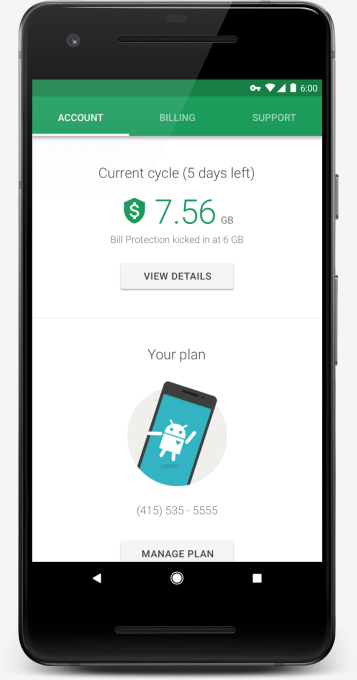 Google’s Project Fi cell service never played the “unlimited data” game that most carriers in the U.S. like to play (and which is never truly unlimited). Instead, Google simply offered data at $10/GB/month and would give you a refund for any data you paid for but didn’t use. Now, however, it’s taking its own stab at what is essentially an unlimited data plan. With its new ‘bill protection’ feature, Project Fi users who use more than 6 GB of data in any given month will never pay more than $60 for that (plus the standard $20 for unlimited talk and text).
Google’s Project Fi cell service never played the “unlimited data” game that most carriers in the U.S. like to play (and which is never truly unlimited). Instead, Google simply offered data at $10/GB/month and would give you a refund for any data you paid for but didn’t use. Now, however, it’s taking its own stab at what is essentially an unlimited data plan. With its new ‘bill protection’ feature, Project Fi users who use more than 6 GB of data in any given month will never pay more than $60 for that (plus the standard $20 for unlimited talk and text).
Update: A Google spokesperson told us that the company also changed how the data billing for Fi works now. You now pay for the data you use at the end of the month, so there’s no need for refunds anymore. We have amended this post to reflect that.
So now, you will simply pay for the data you use, but once you hit 6 GB of data, your overall cost for the month won’t go beyond that $60 limit.
Because no unlimited plan is ever unlimited, Google, too, will slow your data speeds once you hit 15 GB of data. The company says only 1 percent of current Fi users actually use that much, but then that number may go up once you don’t have to pay $150 for using that much data. If you go over 15 GB, you can always opt to pay $10/GB to get faster speeds again (or, in Google’s word, “opt out of slower speeds”).
The bill protection feature includes international data (which is always included) and also applies to data-only plans for laptops, tablets and cars.
If you are on a group plan, the bill protection kicks in at different levels, depending on how many people are on your plan.
Google never positioned Fi as the cheapest carrier and indeed, you’ll find better “unlimited” plans with other carriers. Instead, Google always argued that Fi was a fairer plan that let you pay for what you actually used (though, yeah, you’re paying for unlimited calls and you probably don’t make a lot of those…). With the ability to use three networks (T-Mobile, Sprint and U.S. Cellular), Google also argues that its networks gives you access to more cell towers and 4G LTE than its competitors.
To use Project Fi, you’ll need a phone that supports switching between the various networks. Currently, supported phones include Google’s own Pixel 2 and Pixel lines, as well as the Android One Moto X4 (as well as some of the more recent Nexus phones).